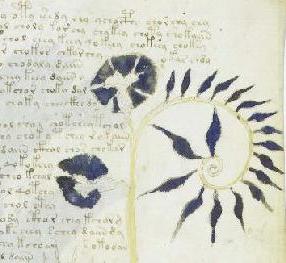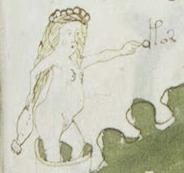
Mailing List & Forum HQ

 |
Mailing List & Forum HQ |
 |
This is the headquarters site for VMs-list, the primary mailing
list for scholars attempting to read the enigmatic Voynich Manuscript.
The list was started in 1991 by Jim Gillogly (then of the RAND
Corporation) and Jim Reeds (then of Bell Labs), and it moved here to
voynich.net in December 2002. It is managed by the Mailman program,
which allows you to subscribe
and unsubscribe
yourself. You can find complete instruction at that link. Send mail to
the list administrator, Rich
SantaColoma, if you
need
help with the directions.
In April of 2020, the administrator began the Official Voynich Net Forum. It is
my hope that the forum will continue the unique tradition of being an
outlet for all ideas about the manuscript, so that researchers of all
backgrounds, with their varied perspectives, will feel free to discuss
both their mainstream, but also sometimes unconvential, and even
controversial, ideas. I have long believed that this
investigation cannot move forward without such an approach, and so
perhaps extending this philosophy to a forum format will induce an even
greater flow of free ideas.
See you there!
Richard SantaColoma
| The tone of the group has been
astonishingly civil and mostly scholarly for the almost 30 years of the
mailing list's existence, despite differences in background
(cryptographers, linguists, botanists, astronomers, paleographers,
medievalists, historians, astrologers and even a few crackpots -- no,
of
course I don't mean you); and differences in approach,
including
half a dozen competing methods of transcribing the Voynich characters.
Jim Reeds has written an introduction to the study of the Voynich Ms. Some images from the Voynich Ms. published by the Beinecke Library on their website are mirrored here. Mysteries surrounding the Voynich Manuscript have puzzled
researchers since the earliest surviving report in the seventeenth
century: we have no clear idea of its date, its author, its provenance,
the meaning of its script, or even the meaning of its drawings. The
suspected owner was the Holy Roman Emperor Rudolf II (1552-1612), who
may have bought it from an unknown seller for 600 ducats. The author of
the
manuscript was then thought to have been the 13th-century monk and
scholar Roger Bacon (1214?-1294?), but this attribution now appears to
be
much too early. |
 |
It may have passed from Rudolf II's hands, then through those of nobleman Jacobus Horcicky de Tepenec, alchemist Georg Baresch, professor Johannes Marcus Marci and scholar Athanasius Kircher S.J. (1602-1680), it may have been filed and forgotten amongst Kircher's papers. It finally surfaced in a collection purchased by book dealer Wilfrid Voynich in about 1912. After his death and the death of his wife, author Ethel (Boole) Voynich, it passed to Wilfrid Voynich's secretary and Ethel Voynich's friend Miss Anne M. Nill, who eventually sold it to rare book dealer Hans P. Kraus. Having failed to sell it for his asking price of $160,000 Kraus donated the Voynich Ms. to Yale University, where it currently resides in the Beinecke Library as MS 408.
 |
During his lifetime Voynich was coy about the provenance of the manuscript, but after his death and that of his widow, Miss Nill revealed that according to a letter from Ethel the manuscript had been found at the Villa Mondragone, an estate near Frascati, Italy which had been bought by the Jesuit Order in 1866 and turned into the international headquarters of the Ghisleri College, and later converted to a boarding school. Recently (23 Dec 2002). Wilfrid Gaye of Sussex called this provenance into question based on documentary evidence from his mother Winifred, the adopted daughter of Wilfrid and Ethel Voynich, but on further checking he found the evidence refers to "a manuscript" rather than specifically identifying this one. |  |
A more detailed account of the history of the Voynich Ms. may be found at Rene Zandbergen's site. Rafal Prinke has developed a graphical timeline of its ownership and related chronology.
The small (16 by 23 cm) manuscript consists of 102 vellum leaves
including several fold-outs, copiously illustrated with water colors.
The manuscript was bound and numbered, probably by a later hand than
the author's. Fourteen of the numbered leaves are missing; comparing
Newbold's careful catalog with Kraus's shows at least six of
these disappeared since Voynich obtained the manuscript. An important
signature was found by chance with
infra-red light and made legible with chemicals, that of Jacobus
Horcicky de Tepenec, mentioned above. In 2009, the University of
Arizona tested the vellum for radiocarbon age, and determined that it
was made between 1404 and 1438. Samples of paint and ink was also analyzed
by McCrone Associates at about this time. Their tests did not turn
up any substance which would prove a time later than the C14 dating of
the vellum... however, the ink was not dated.
 |
The text is written in a neat and clear script which has defied attempts at interpretation by some of the best cryptographic minds available including Athanasius Kircher; noted cryptologist Brig. John Tiltman, head of the British codebreaking establishment at Bletchley Park during World War II; and William F. Friedman, the famous American codebreaker who turned cryptanalysis into a science and led the team that broke the Japanese Purple cipher machine |
A MHonArc-produced archive for 2002-2004
is available:
An unstructured archive of old mailing
list traffic up through the end of 2002 is available.
The below search box will allow searching later Voynich List Traffic,
to date:
List of Voynich
links:
|